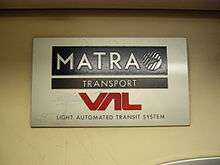Taipei Metro VAL256
| Taipei Metro VAL 256 | |
|---|---|
|
Three VAL 256 EMUs at reverse siding near Zhongshan Junior High School Station on the Wenshan Line, March 2008 | |
|
Interior of a VAL 256 coach | |
| In service | 28 March 1996-present |
| Manufacturer | Matra and GEC Alsthom |
| Family name | VAL |
| Constructed | c.1990-1993 |
| Number built | 102 vehicles (51 trainsets) |
| Number in service | 102 vehicles (51 trainsets) |
| Formation | 2 x 2 cars per trainset (originally 2 cars) |
| Fleet numbers | 01 ~ 51 |
| Capacity |
24 seats, 90 standing per car (456 passengers in 4-car set) |
| Operator(s) | Taipei Rapid Transit System |
| Depot(s) | Muzha, Neihu |
| Line(s) served | Wenhu Line (Brown Line) |
| Specifications | |
| Car body construction | Aluminium |
| Car length | 13,780 mm |
| Width | 2,560 mm |
| Height | 3,510 mm |
| Maximum speed | 80 km/h |
| Weight | 148 tonnes |
| Electric system(s) | 1500 V Third-rail DC |
| Safety system(s) | ATC (CBTC) |
| Track gauge | 1,880 mm (6 ft 2 in)[1] |
The Taipei Metro VAL 256 is the first generation of automated guideway transit rolling stock to be used on Taipei Metro Wenhu Line (Brown Line).
A total of 51 2-car train sets were built by GEC Alsthom from about 1990 to 1993, for a total of 102 cars. They entered service in 1996 as the first trains on the newly-opened Metro system. They are part of the VAL family of automated, driverless rubber-tired metros developed by the French company Matra. Each four-car train is formed by two coupled two-car trainsets. Any two sets can be coupled and their numbers do not need to be consecutive, unlike heavy-capacity trains.
Within a year of revenue operations, Matra terminated the service contract, removing all maintenance crew. They filed and won a complaint against the Taipei City Government over contract compensation delay. The VAL 256 trains remained in service for twelve more years, serviced by TRTC engineers and Academia Sinica researchers.[2]
The VAL 256 cars originally employed a fixed-block ATC/ATO system derived from the MAGGALY technology found on Lyon Metro Line D.[3][2] When the Muzha/Wenshan line was extended into Neihu in June 2003, Bombardier Transportation was contracted to replace the Matra-based system with its own, computerized CITYFLO 650 CBTC system, and overhauling the older Matra cars to function under the new system.[4] This took place over a period of 17 months and all 51 sets returned to service in December 2010.
Bombardier's contract also involved supplying 101 newly-built vehicles to expand the existing fleet.[2] Integration of the Bombardier-built cars with the Matra-built cars led to multiple system malfunctions and failures along the Wenshan and Neihu Lines.[5]
The VAL 256 cars are also used by O'Hare International Airport's Airport Transit System, albeit with the majority of the seats removed since the system's primary purpose is to move passengers between terminals as well as provide access to the economy parking lots, rental car facility, and the Metra station.
 Matra manufacturer's plate
Matra manufacturer's plate GEC Alsthom manufacturer's plate
GEC Alsthom manufacturer's plate- VAL 256s on O'Hare International Airport's Airport Transit System
See also
References
- ↑ 內湖線則採用膠輪/鋼軌系統,中心線間距為1,880mm。此外,文山線因採膠輪/水泥軌道系統,一般來說並無軌距之分,但其凸出於路面的兩條行車水泥軌枕,中心線間距為1,880mm。
- 1 2 3 Taipei Metro – Approaches and strategies in managing an extensive and diverse rail framework, Richard C.L. Chen, TRTS, retrieved 26 April 2008
- ↑ .
- ↑ "CITYFLO 650 - Neihu LINE, Taiwan". Bombardier Transportation.
- ↑ "Neihu, Muzha MRT lines closed down for 4 hours". Taiwan News Online. 2009-08-06. Retrieved 2009-08-12.